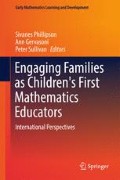Abstract
Much has been written about out of school contexts and their importance and relevance to learning mathematics. This chapter explores the swim environment for under 5s and its potential for learning mathematics. The findings are drawn from a much larger, international study on the potential impact of early years swimming to add capital to young children. The focus here is on adding mathematical capital to under-5s. It was found the there is a very strong case for early years swimming to be of significant benefit to young children. Drawing on both internationally and nationally accredited and recognised psychological testing and observations of lessons, the chapter explores specific results and then offers a potential explanation for how such results may have been achieved by drawing on lesson observations. The results provide interesting and valuable insights into the potential of non-school contexts to add mathematical capital to young children.
Access this chapter
Tax calculation will be finalised at checkout
Purchases are for personal use only
Notes
- 1.
Not to be confused with Swimming Australia, the national sporting body responsible for the promotion and development of competitive swimming in Australia at all levels. Swimming Australia has almost 100,000 members and just over 1100 swimming clubs nationwide (www.swimming.org.au).
- 2.
Pseudonyms are used in this paper to protect the identity of participants and sites.
- 3.
A term of affection often used by teachers, particularly for young boys.
References
Australian Bureau of Statistics. (2009). Children's participation in organised sport and dancing, perspectives on sport (4156.0.55.001), December. www.abs.gov.au/ausstats/abs@.nsf/Products/4156.0.55.001~Dec+2009~Main+Features~Children%27s+Participation+in+Organised+Sport+and+Dancing?OpenDocument. Accessed 06 June 2012.
Bernstein, B. (1990). The structuring of pedagogic discourse: Vol 4. Class, codes and control. London: Routledge.
Bourdieu, P. (1983). Forms of capital. In J. G. Richardson (Ed.), Handbooks of theory and research of the sociology of education. New York: Greenwood Press.
Bowes, J., Harrison, L., Sweller, N., Taylor, A., & Neilsen-Hewett, C. (2009). From child care to school: Influences on children’s adjustment and achievement in the year before school and the first year of school. Research Report to the NSW Department of Community Services. Children and Families Research Centre, Macquarie University and School of Teacher Education, Charles Sturt University.
Centre for Disease Control. (2012). Developmental Milestones. http://www.cdc.gov/ncbddd/actearly/milestones.html. Accessed May 15 2012.
Diem, L. (1982). Early motor stimulation and personal development. A study of four-to-six-year-old German Children. Journal of Physical Education, Recreation and Dance, 53, 23–25.
Duan, J., Huang, L., & Zeng, D. (2005). The effects of infant swimming on the passage of the meconium. Journal of Nursing Science, 3.
Font-Ribera, L., Villanueva, C. M., Nieuwenhuijsen, M. J., Zock, J.-P., Kogevinas, M., & Henderson, J. (2011). Swimming pool attendance, asthma, allergies, and lung function in the Avon Longitudinal Study of Parents and Children Cohort. American Journal of Respiratory Critical Care Medicine, 183, 582–588.
Fragala-Pinkham, M., Haley, S., & O’Niell, M. (2008). Group aquatic aerobic exercise for children with disabilities. Developmental Medicine and Child Neurology, 50, 822–827.
Hutzler, Y., Chacham, A., Bergman, U., & Szeunberg, A. (2008). Effects of movement and swimming program on vital capacity and water orientation skills of children with cerebral palsy. Developmental Medicine and Child Neurology, 40, 176–181.
Jorgensen, R. (2012). Engaging learning environments: Under-5s swimming as a site for capital building. Australian Journal of Early Childhood, 37, 127–131.
Jorgensen, R. (2013) Early-years swimming: creating opportunities for adding mathematical capital to under 5s. In V. Steinle et al. (Eds.), Proceedings of the annual mathematics education research group of australasia Conference, Melbourne. Melbourne: MERGA.
Jorgensen, R., & Grootenboer, P. (2011). Early years swimming as new sites for early mathematical learning. In Proceedings of the Annual Mathematics Education Research Group of Australasia Conference. Alice Springs: MERGA.
Royal Life Saving Society (Australia) & AustSwim. (2010). 2010 Survey of swim school managers report. Sydney: RLSSA. htttp://www.royallifesaving.com.au/www/html/2808-research-reports.asp. Accessed 12 Oct 2012
Sigmundsson, H., & Hopkins, B. (2010). Baby swimming: Exploring the effects of early intervention on subsequent motor abilities. Child: Care, Health and Development, 36, 428–430.
Smith, D. (2015). Personal communication: Number of pools in Australian Homes. Swimming Pool and Spa Association of Australia.
Wang, J.-S. (2009). The effects of a swimming intervention for children with asthma. Respirology, 14, 838.
Zevenbergen, R. (2001). Mathematics, social class and linguistic capital: An analysis of a mathematics classroom. In B. Atweh & H. Forgasz (Eds.), Socio-cultural aspects of mathematics education: An international perspective (pp. 201–215). Mahwah, NJ: Lawrence Erlbaum.
Zevenbergen, R., Hyde, M., & Power, D. (2001). Language, arithmetic word problems and deaf students: Linguistic strategies used by deaf students to solve tasks. Mathematics Education Research Journal, 13, 204–218.
Acknowledgments
I would like to thank Drs Roland Simon for the statistical advice on the child development tests. I also recognise the advice and support offered by Dr Laurie Lawrence and Ross Gage with respect to the nuances of the swim industry. I would also acknowledge the support of members of the swim industry, particularly ACTSA and Swim Australia who offered both financial support and access to swim schools in order that the research could be undertaken. The views in this chapter are those of the author and independent of the sponsoring organisations.
Author information
Authors and Affiliations
Corresponding author
Editor information
Editors and Affiliations
Rights and permissions
Copyright information
© 2017 Springer Science+Business Media Singapore
About this chapter
Cite this chapter
Jorgensen, R. (2017). Supporting Early Mathematics Learning: Building Mathematical Capital Through Participating in Early Years Swimming. In: Phillipson, S., Gervasoni, A., Sullivan, P. (eds) Engaging Families as Children's First Mathematics Educators. Early Mathematics Learning and Development. Springer, Singapore. https://doi.org/10.1007/978-981-10-2553-2_13
Download citation
DOI: https://doi.org/10.1007/978-981-10-2553-2_13
Published:
Publisher Name: Springer, Singapore
Print ISBN: 978-981-10-2551-8
Online ISBN: 978-981-10-2553-2
eBook Packages: EducationEducation (R0)

